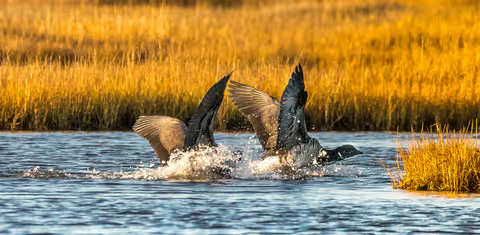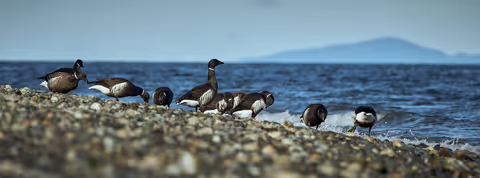Brant Geese



Introduction
Now that we are in the depths of winter, our little piece of coastal paradise is playing host to a lot of Canada Geese and Cackling Geese, who are spending the cold weather months here to get away from frigid conditions in Northern Canada and Alaska. You can see them all over Ocean Shores in parks, canals, lagoons, and, if you're lucky enough to own a waterfront home, in your own backyard. As the calendar turns toward spring, many of these geese will begin migrating north for their annual breeding seasons. However, they won’t be the only species of goose that will migrating through town at that time. There will be a third species joining them for the journey that you might have also seen in recent weeks. That species is Brant Geese (scientific name: Branta bernicla).
Size and Color
Brant Geese are small, compact creatures with short necks and stubby bills (1), Male Brant Geese are approximately 25 inches long with a wingspan of 48 inches. They typically weigh around 3.25 pounds. Female Brant Geese are smaller, with a length of 23 inches, a wingspan of 44.5 inches, and an average weight of 2.25 pounds (5).
Adult Brant Geese have black heads and breasts, brown wings, white undertails, and pale flanks. Their necks feature white markings that vary in size. Any part of their neck that doesn't feature a white marking is black (1). Their bellies can vary in color from pale brown to blackish, depending on which part of North America they are in (1). Here in Ocean Shores, you are more likely to see Brant Geese with blackish bellies. Brant Geese with pale brown bellies are more common in Eastern North America (1). The color scheme for juvenile geese is similar to that of adults. However, they do not have as many white markings on their necks. Additionally, they have pale fringes on their wing coverts (1).
Diet and Nesting
Brant Geese primarily forage for food by swimming into shallow water, and tipping themselves forward to gain access to aquatic vegetation, which makes up most of their diet (3). Eelgrass, widgeon grass, green algae, and rockgrass are among their favorite aquatic plans to eat. Brant Geese also eat some aquatic insects, worms, and mollusks (3). In recent decades, it has been discovered that some Brant Geese have started patronizing upland fields to graze on grass (2).
Brant Geese typically establish pair bonds on their wintering grounds, before migrating north to breed. Their preferred nesting sites are on small islands in tundra ponds or on slight rises in low, grassy flats (3). The nests are normally located within five miles of the coast, and often fall victim to storm tides once the breeding season is over. The nest is a shallow bowl of grass and other materials that is lined with a heavy coating of down (3).
Eggs and the Young
Brant Geese lay approximately three to five eggs. The eggs start out being creamy white to pale olive in color, before eventually becoming nest-stained (3). The incubation process is handled exclusively by the female, and runs for twenty-two to twenty-six days. When the female has to leave the nest to eat, she covers the eggs with down to keep them from getting too cold. The young leave the nest with two days of hatching, and are tended to by both parents (3). While both parents lead their young to feeding areas, the young have to find their own food once they get there. Since daylight hours are extremely long in the Arctic during the summer months, the young are able to feed at all hours and develop rapidly, fledging in approximately forty to fifty days (3).

Ranges and Habitats
Brant Geese are perhaps the most ambitious members of their species. No other geese nest as far north as they do, and few other geese migrate as far (3). These small geese are seemingly the ultimate snowbirds, flying thousands of miles at high altitudes between their summer and winter homes (3). Brant Geese spend their summers in the Arctic (4). Their preferred breeding habitats are on islands, in tundra, and in marshlands (1). When it comes time for the geese to molt, they will leave their breeding habitats and visit similar, nearby habitats before flying south for the winter (1). During the winter months, Brant Geese spend their time in an array of coastal locations from Southwestern Alaska to Baja California in the west, and from New England to North Carolina's Outer Banks region in the east (4). Their preferred winter habitats are in mudflats, estuaries, lagoons, and saltmarshes.They also spend time on barrier beaches and the shores of the oceans (1). In some places, Brant Geese have become frequent visitors to parks and golf courses where hunting is off limits (2).
References
© Ian D. Caldwell, January 2023
Touch whale bones, examine shipwreck artifacts and connect with the coast's living history.

Support our mission, get involved in educational programs, or contribute through donations and volunteering.